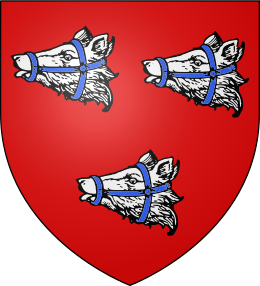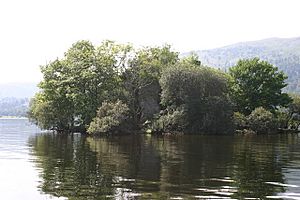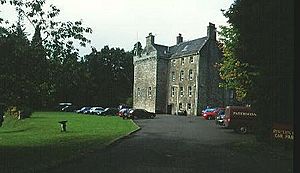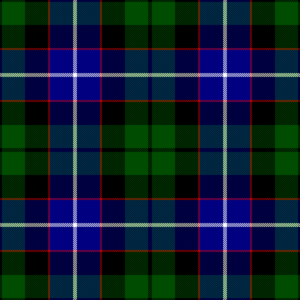Clan Galbraith facts for kids
Quick facts for kids Clan Galbraith |
|
|---|---|

Crest: bear's head couped argent muzzled azure
|
|
| Motto | AB OBICE SUAVIOR "Gentler Because of the Obstruction" or AB OBICE SAEVIOR "Fiercer Because of the Obstruction" |
| Profile | |
| Region | Lowlands |
| District | Stirlingshire |
 |
|
| Clan Galbraith has no chief, and is an armigerous clan | |
| Historic seat | Culcreuch Castle |
| Last Chief | Galbraith of Culcreuch |
Clan Galbraith is a Scottish clan, which is like a large family group with a shared history. This clan does not currently have a chief who is officially recognized by the Lord Lyon King of Arms. Because of this, Clan Galbraith is known as an armigerous clan. This means it doesn't have an official standing under Scots Law right now.
The name Galbraith comes from an old Gaelic word. It means "British foreigner." This name showed the difference between the Gaels (who came to Scotland around the 5th century) and the native Britons who spoke Welsh. The early Galbraiths lived in the Lennox area, near Loch Lomond in Scotland.
Contents
What Does "Galbraith" Mean?

The name Galbraith comes from Gaelic words. Gall means "stranger," and Breathnach means "Briton." So, it means "British foreigner." This name helped tell apart the Gaels from the native Britons. These Britons lived in the Kingdom of Strathclyde, especially around Dumbarton. They were different from both the Highland Gaels and the Lowland Angles until the 1300s.
In Scottish Gaelic, the Galbraiths are sometimes called Breatanuich or Clann-a-Bhreatannuich. These names mean "Britons" or "Children of the Britons." The first Galbraiths lived in the Lennox area, close to Loch Lomond. Their main home was on an island called Inchgalbraith. This island is on the west side of Loch Lomond, near Luss. Some people think the Galbraith family's coat of arms, which shows three bear heads, might be linked to the British name Arthur, which some believe means "bear."
Clan Galbraith's History

The first chief of Clan Galbraith was Gilchrist Bretnach. He married the granddaughter of the first Earl of Lennox.
The fourth chief was Sir William Galbraith of Buthernock. He married the sister of "Black Comyn." The Comyns were a very powerful family in Scotland. However, Sir William chose to go against the Comyns. He helped rescue the young king, Alexander III, from their control. Sir William became one of the leaders who ruled Scotland in 1255.
Sir William's son, Sir Arthur, was the fifth chief. He supported Robert the Bruce, a famous Scottish king. Sir Arthur also married the sister of Sir James Douglas. Sir James Douglas is well-known for carrying Robert the Bruce's heart to the Holy Land after the king's death.
A part of the Galbraith family lived at Culcreuch Castle starting around 1320. By the end of that century, they became the main leaders of the clan. In 1425, the ninth chief, James Galbraith of Culcreuch, joined a rebellion against King James I of Scotland. This rebellion supported Murdoch Stewart, Duke of Albany, who had been removed from power. After the rebellion failed, about 600 clan members had to leave their homes. They were sent to Kintyre and the Isle of Gigha. There, they took on new names like MacBhreatneaich or M'Vretny, meaning "son of the Briton."
In 1489, the twelfth chief, Thomas Galbraith of Culcreuch, was captured by King James IV and faced serious consequences.
The Clan's Difficult Times

The 17th chief, Robert Galbraith of Culcreuch, faced many problems that led to difficulties for the clan. Before 1593, his widowed mother married the chief of the Clan MacAulay, Aulay MacAulay of Ardincaple. Robert Galbraith was very unhappy about this marriage.
In 1593, Robert Galbraith got a special permission to hunt down the Clan Gregor. However, the MacAulays and Colquhouns worried that Galbraith's real plan was to attack them instead. They believed he was working with the Buchanans to get revenge on the MacAulays and Colquhouns, pretending to be chasing the MacGregors. Because of these concerns, Robert Galbraith's special permission was taken away.
In 1612, Robert and his wife had to give up their land called West Milligs to his mother. This land had been with the Galbraiths of Culcreuch since the 1400s, but it was then lost to the MacAulays.
By 1622, Robert Galbraith, the Laird of Culcreuch, was in debt and had a serious conflict with his brother-in-law. He was declared an outlaw and had to give up Culcreuch Castle. Galbraith then left Scotland and went to Ireland. He died there ten years later. He left nothing for his son. His grandson, the 19th Chief of Clan Galbraith, was the last chief in his family line.
Clan Symbols Today
Today, people who are part of Scottish clans sometimes wear Scottish crest badges and clan tartans to show their connection.
The crest badge for Clan Galbraith members has a special design: a bear's head with a muzzle. The clan's motto is AB OBICE SUAVIOR. This Latin phrase means "gentler because of the obstruction." This motto comes from an old poem by Ovid. The original phrase described a river that flowed more fiercely when blocked. But the Galbraith motto changed "fiercer" to "gentler," which might refer to the bear's muzzle on the crest.
The "Galbraith" tartan is also known by other names, like Russell, Mitchell, and Hunter. It was recorded as Galbraith by the Highland Society of London. However, it was also recorded as Hunter in 1819 and Russell in 1847 by a company called William Wilson and Sons.
See also
- Galbraith
- Culcreuch Castle

